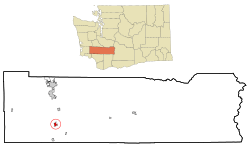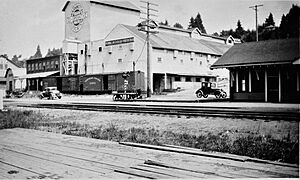Winlock, Washington facts for kids
Quick facts for kids
Winlock
|
|
|---|---|

Location of Winlock in Washington
|
|
| Country | United States |
| State | Washington |
| County | Lewis |
| Area | |
| • Total | 1.29 sq mi (3.35 km2) |
| • Land | 1.29 sq mi (3.35 km2) |
| • Water | 0.00 sq mi (0.00 km2) |
| Elevation | 305 ft (93 m) |
| Population
(2020)
|
|
| • Total | 1,472 |
| • Density | 1,105.26/sq mi (426.73/km2) |
| Time zone | UTC-8 (PST) |
| • Summer (DST) | UTC-7 (PDT) |
| ZIP code |
98596
|
| Area code(s) | 360 |
| FIPS code | 53-79275 |
| GNIS feature ID | 1509597 |
Winlock (/wɪnlək/) is a small city in Lewis County, Washington, United States. In 2020, about 1,472 people lived there. The city was named after William Winlock Miller, an army general who lived there for a short time. Winlock is famous for having the World's Largest Egg. This shows its past importance as a big producer of eggs. Many immigrants from Finland, Germany, and Sweden moved to Winlock early in its history.
Contents
History of Winlock
How Winlock Started
Winlock began around 1871 as a camp for workers building the Northern Pacific Railroad. This camp was first called Wheeler's Camp. The railroad was building its line from Kalama to Tacoma, Washington. Dr. C. C. Pagett, an early resident, gave the land for the town. In 1873, he named it after General William Winlock Miller from Olympia. Miller had promised to give a school bell to the town if it was named after him. The town officially became a city in 1883.
Early Jobs and Industries
Lumbering was the first main job in Winlock. Many sawmills were built starting in the late 1800s. By the late 1920s, four mills were running. They employed 350 men and produced a lot of fir lumber each year.
Farming grew in the early 1900s, especially raising chickens and producing eggs. Around 1920, a branch of the Washington Cooperative Egg & Poultry Association built a large building. It was in the north part of town, near the railroad tracks. This building stored grain and processed poultry. It is still standing today. Several places that hatched baby chicks were also in town. In 1928, over 750,000 baby chicks were produced.
In 1922, a local newspaper said that only Petaluma, California produced more eggs than Winlock in the U.S. In just one weekend in 1923, Winlock sent 38,400 dozen eggs to New York state. At that time, Winlock was known as the "Egg and Poultry Capital of the World."
Winlock in the 21st Century
In late 2022, a fire in downtown Winlock destroyed the old Warne's Drug Store building. This building was first built in 1911. It burned down the next year but was rebuilt quickly. For a century, it housed various businesses, including the Winlock News. Before the fire, it was used as a hostel for six years.
In 2023, the city wanted to add more land to Winlock. This land was called the urban growth area (UGA). Some residents in the UGA protested this idea. A court first said no to the plan. However, citizens then asked the Washington State Boundary Review Board to look at the proposal. The board approved the plan in August 2023. The Winlock city council then voted to add the land that autumn.
Geography and Nature
Winlock covers about 1.29 square miles (3.34 km2) of land. After the 2023 land addition, the city grew by another 1,355 acres (2.1 sq mi).
Olequa Creek flows through the middle of town from north to south. This creek is a main branch of the Cowlitz River.
To the west of Winlock are the eastern parts of the Willapa Hills. To the east are flat prairies. A notable spot about four miles west of town is Sam Henry Mountain. It is 1,492 feet (455 m) tall and named after an early railroad manager. Mt. St. Helens is about forty miles (64 km) to the east. You can see it from some places around Winlock. In May 1980, Winlock was covered with about one inch (2.5 cm) of volcanic ash. This happened after a big eruption of Mount St. Helens.
Population Details
| Historical population | |||
|---|---|---|---|
| Census | Pop. | %± | |
| 1900 | 655 | — | |
| 1910 | 1,140 | 74.0% | |
| 1920 | 832 | −27.0% | |
| 1930 | 864 | 3.8% | |
| 1940 | 861 | −0.3% | |
| 1950 | 878 | 2.0% | |
| 1960 | 808 | −8.0% | |
| 1970 | 890 | 10.1% | |
| 1980 | 1,052 | 18.2% | |
| 1990 | 1,027 | −2.4% | |
| 2000 | 1,166 | 13.5% | |
| 2010 | 1,339 | 14.8% | |
| 2020 | 1,472 | 9.9% | |
| U.S. Decennial Census 2020 Census |
|||
Winlock Population in 2010
According to the 2010 census, Winlock had 1,339 people. There were 475 households, which are groups of people living together. The city had about 1038 people per square mile.
Most residents (84.7%) were White. About 13.1% of the population was Hispanic or Latino.
About 38.9% of households had children under 18 living with them. The average household had 2.79 people. The average age in the city was 34 years old. About 30.2% of residents were under 18.
Arts and Culture in Winlock
Festivals and Events
The first Winlock Egg Days Festival happened in 1921. This was after a paved road, Washington State Route 505, was finished. The event was first called "Poultry and Egg Day." This yearly festival celebrates the city's history with chickens and eggs. A local resident is honored as a festival marshal each year.
Since 2000, Winlock has hosted the annual Winlock Pickersfest. This festival is held at Winolequa Park. It used to be called the Winlock Bluesgrass Festival. The festival focuses on stringed instruments, like the banjo. It includes different music styles such as Americana, bluegrass, and jazz. This three-day event usually takes place on the first weekend of August.
Historic Places
Near Olequa Creek, west of downtown, is the Sacred Heart Catholic Church. It was built in 1908. The church closed in 2014 due to money problems. In November 2024, it reopened as a part of the Saint George Byzantine Catholic Church. A local group bought the building to fix it up and save this historic church.
The Famous Winlock Egg
The Winlock Egg was named the world's largest egg by Ripley's Believe It or Not! in 1989. The egg you see today is the fourth version of the original.
The first egg was built for a celebration in 1923. This celebration was for the opening of the Pacific Highway Bridge. The idea for an egg came from John G. Lawrence. He was the manager of the new egg and poultry co-op. He wanted to show how important the egg industry was in Winlock. At that time, farmers in Winlock shipped a quarter million cases of eggs each year.
The first egg was made of a wood frame covered with white canvas. It was put on a truck for a parade. The parade traveled from Olympia, Washington, to Salem, Oregon. This celebrated new trade between Washington and Oregon. After the parade, the egg was placed near the train station. It has been a symbol of local pride ever since.
The first egg was covered with plaster. It was 12 feet (3.7 m) long and 8 feet (2.4 m) wide. After 20 years, the 2,000 lb (910 kg) egg was old and broken. It was replaced by a plastic version. This plastic egg lasted until 1958, when it fell and cracked. A fiberglass egg was made next, but it wasn't put up until 1965. This fiberglass egg weighed 1,500 pounds (680 kg) and was 15 feet (4.6 m) long. Some people thought it looked too much like a football. The community built a park around it, called Vern Zander Memorial Park. A sign there called it the world's largest egg.
Another fiberglass egg was put in place in 1991. This new 1,200 lb (540 kg) sculpture was part of the Winlock Egg Day Parade. Then it was placed in Vern Zander Memorial Park. It sits on top of a 10 feet (3.0 m) steel support. In recent years, the egg has been painted for special events. It was painted like an American flag after the 9/11 attacks. It was also decorated with the Seattle Seahawks logo in the 2010s.
Parks and Recreation
Winlock is home to Winolequa Park, the city's largest public park. This park, also known as Winolequa Memorial Park, was started by community volunteers in the 1960s and 1970s.
Since 2018, community groups put up the Winlock Memorial Christmas Tree. This happens at Vern Zander Memorial Park during the holidays. As of 2024, about 450 ornaments are hung on the tree. Each ornament has the name of a Winlock resident who has passed away. This honors "those who are gone but will never be forgotten."
Winlock was once planned to be the site for a large horse riding center. This center was called the Southwest Washington Regional Equestrian Center. Planning for it began in 2006. The horse arena was supposed to hold over 7,000 people. It was estimated to cost between $50 million and $80 million. The center was planned to host many professional horse and rodeo events. A site was chosen in 2008. However, the project was canceled in Winlock that same year. This happened because a project manager and developer were fined for illegally filling wetlands at the location. In 2009, there was a proposal to move the arena to Napavine.
Education and Sports
High School Sports
The Winlock high school football team won state championships in 1955, 1958, and 1959. Each year, a senior player receives the Otis Roundtree Award. This award is named after a local person who played football for the University of Washington in the 1890s. This tradition started in the 1920s. It honors the most inspiring football player on the team. It is one of the oldest high school awards still given in the state.
City Infrastructure
Washington State Route 505 starts in Winlock. It goes east to Interstate 5 and then to the town of Toledo. Highway 603, an older state road, goes north from Winlock. It connects with State Route 6 about 4 miles west of Chehalis.
The Burlington Northern double track railroad line runs through the middle of Winlock. Union Pacific and Amtrak trains also use these tracks. This line is the only rail connection between Seattle/Tacoma and Portland. It has a lot of train traffic. Freight service is available here, but Amtrak passenger trains do not stop. The closest Amtrak station is in Centralia.
Winlock started building a fiber optic internet expansion in 2023. This is part of a larger regional internet project. It received a grant of $23.5 million from the Washington State Broadband Office. An extra $2.3 million came from a regional communications company. Once finished, Lewis County will own this fast internet system. The project was first planned to be done in 2024, but it is now expected to finish in late 2026.
See also
 In Spanish: Winlock (Washington) para niños
In Spanish: Winlock (Washington) para niños



